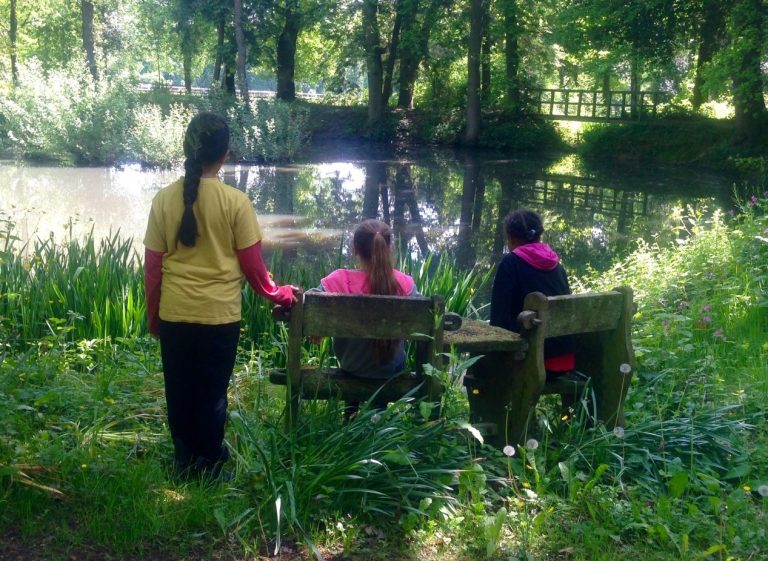
It seems incongruous to say it – with the Coronavirus turning all our lives up-side down and doing the same for the country’s government and finances – but at the moment, at least, everything in the garden, or more particularly the Woods, is lovely.
And thanks to being lockeddown at Checkendon, for the first time, my wife Jennifer and I are able to watch the Spring and our Spring flowers unfold genus by genus.

The Camellias, which we planted about ten years ago have been incredible and it never ceases to amaze me how the flowers vary so much in their structure – from the most voluptuous and showy to small and rigidly geometric and everything in between and with colours that stand out, jewel-like, a hundred yards away. All of them (apart from a small number, which we brought here from my Mother’s garden in Henley, when she died) were supplied by Burncoose Nurseries in Cornwall, which is owned by the Williams family from Caerhays Castle and the Caerhays Estate nearby. Their garden at Caerhays, near St Austell is one of the great gardens of Cornwall.
John Charles(JC) Williams(1861 – 1939) inherited the Caerhays Estate when he was only 18 and he became a passionate gardener and plant collector and plant-breeder. He also contributed substantially to several plant-hunting expeditions to China and, in return, received seeds for newly discovered Rhododendrons, Magnolias, Camellias, Azaleas and other plants and trees, very many of them still represented in the Caerhays’ garden near St Austell.
In the 1920’s JC Williams became particularly interested in Camellias and he was responsible for making the hybrid cross between Camellia japonica and Camellia saluenensis, which resulted in the famous williamsii hybrids, of which there are now thousands, which combine the hardy characteristics of the japonica with the floriferous characteristics of the saluenensis. Until cross was made, Camellias were generally regarded as hot-house/conservatory plants.
Every day during the Spring – and particularly this Spring – I give thanks to JC (Williams) – and also to Climate Change!


And just as the Camellias may have peaked, the Bluebells are beginning to flower and immediately the smell in the air is all honey. It looks as if this could be a vintage year and the mowing and clearing which we did over the last two years seems to be really paying off. A few weeks ago we were planning to have a Bluebell day here for friends on 30 April but like so much this year it has had to be called off, because of the virus. In a sense lucky, because I think the Bluebells are going to over well before then.
This year the Bluebells are sharing the limelight with Wood Anemones and, in some cases Stitchwort. In combination or alone they are gorgeous.
Another absolutely winner already this year are violets. They’re everywhere ranging from the deepest violet, through various shades of violet and blue to, I’m sure we have it somewhere, we certainly used to, pure white.
I wonder whether others have noticed it that the best clumps of deep violet appear under our rusting estate railings – particularly on the path to the Church. Is there a reason for them doing so well right under the railings and does the rust have something to do with their exquisite colour?

And that reminds me. The Horse Chestnuts are just coming into leaf and you can see thousands of flower candles forming, in time for the early Summer. It always makes me laugh that when we go abroad, we are told to look out particularly for the great flowering trees of Florida, Georgia and India etc when I think of our flowering trees our flowering Wild Cherry, Horse Chestnut, Sweet Chestnut and Tulip Trees and Limes, which flower in the Summer and whose scent wafts unmistakably through the house more than a hundred yards away.

And finally – in what looks like a bumper Spring, where we can only mention a tiny part of the action/actors – there are the Cherries.
They are all have having a wonderful Spring: the eating cherries – hurrah, I hope there won’t be a bad frost over the next couple of weeks – the flowering cherries and also our Wild Cherry (Prunus avium), the latter being huge trees and a fantastic sight, from a distance and up close.
I smile when I hear people talk of the flowering cherry blossom in Japan and the wisteria in Italy. What about our Spring flowering shrubs and trees: our Blackthorn and May, our Pears, Plums, Apples, Crab Apples, Quince, Medlars etc – roughly in order of appearance?
But it’s not a competition. We’re just lucky to live in England – Coronavirus, notwithstanding.

Toby Greenbury, very much in his happy place, aboard his AS 940 Sherpa – a cross between a go-cart and a Lamborghini (so we are told).

